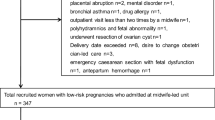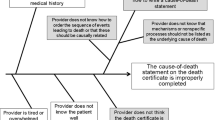Abstract
Background:
To examine variation in quality report viewing and assess correlation between provider report viewing and neonatal intensive care unit (NICU) quality.
Methods:
Variation in report viewing sessions for 129 California Perinatal Quality Care Collaborative NICUs was examined. NICUs were stratified into tertiles based on their antenatal steroid (ANS) use and hospital-acquired infection (HAI) rates to compare report viewing session counts.
Results:
The number of report viewing sessions initiated by providers varied widely over a 2-year period (median=11; mean=25.5; s.d.=45.19 sessions). Report viewing was not associated with differences in ANS use. Facilities with low HAI rates had less frequent report viewing. Facilities with high report views had significant improvements in HAI rates over time.
Conclusions:
Available audit and feedback reports are utilized inconsistently across California NICUs despite evidence that report viewing is associated with improvements in quality of care delivery. Further studies are needed for reports to reach their theoretical potential.
This is a preview of subscription content, access via your institution
Access options
Subscribe to this journal
Receive 12 print issues and online access
$259.00 per year
only $21.58 per issue
Buy this article
- Purchase on Springer Link
- Instant access to full article PDF
Prices may be subject to local taxes which are calculated during checkout



Similar content being viewed by others
References
Shah V, Warre R, Lee SK . Quality improvement initiatives in neonatal intensive care unit networks: achievements and challenges. Acad Pediatr 2013; 13 (6 Suppl): S75–S83.
Profit J, Soll RF . Neonatal networks: clinical research and quality improvement. Semin Fetal Neonatal Med 2015; 20 (6): 410–415.
Billett AL, Colletti RB, Mandel KE, Miller M, Muething SE, Sharek PJ et al. Exemplar pediatric collaborative improvement networks: achieving results. Pediatrics 2013; 131 (Supplement 4): S196–S203.
Gould JB . Quality improvement in perinatal medicine. NeoReviews 2004; 5 (2): e33–e41.
Hysong SJ, Best RG, Pugh JA . Audit and feedback and clinical practice guideline adherence: making feedback actionable. Implement Sci 2006; 1: 9.
Grimshaw JM, Eccles MP, Walker AE, Thomas RE . Changing physicians’ behavior: what works and thoughts on getting more things to work. J Contin Educ Health Prof 2002; 22 (4): 237–243.
Hysong SJ, Khan MM, Petersen LA . Passive monitoring versus active assessment of clinical performance: impact on measured quality of care. Med Care 2011; 49 (10): 883–890.
Hysong SJ . Meta-analysis: audit and feedback features impact effectiveness on care quality. Med Care 2009; 47 (3): 356–363.
Bowles S, Pettit J, Mickas N, Nisbet C, Proctor T, Wirtschafter D . California Perinatal Quality Care Collaborative Neonatal Hospital-Acquired Infection Prevention, 2007. Available at: https://www.cpqcc.org/sites/default/files/2007HAIToolkit.pdf. Last accessed date 23 March 2017.
Hallman M, Peltoniemi O, Kari MA . Enhancing functional maturity before preterm birth. Neonatology 2010; 97 (4): 373–378.
Roberts D, Dalziel S . Antenatal corticosteroids for accelerating fetal lung maturation for women at risk of preterm birth. Cochrane Database Syst Rev 2006; Issue 3. Art. No.: CD004454.
Wong D, Abdel-Latif M, Kent A . Antenatal steroid exposure and outcomes of very premature infants: a regional cohort study. Arch Child Fetal Neonatal Ed 2014; 99 (1): F12–F20.
Bartholomew J, Kovacs L, Papageorgiou A . Review of the antenatal and postnatal use of steroids. Indian J Pediatr 2014; 81 (5): 466–472.
Liggins GC, Howie RN . A controlled trial of antepartum glucocorticoid treatment for prevention of the respiratory distress syndrome in premature infants. Pediatrics 1972; 50 (4): 515–525.
Guinsburg R, Branco de Almeida MF, Dos Santos Rodrigues Sadeck L, Marba ST, Suppo de Souza Rugolo LM, Luz JH et al. Proactive management of extreme prematurity: disagreement between obstetricians and neonatologists. J Perinatol 2012; 32 (12): 913–919.
Payne NR, Carpenter JH, Badger GJ, Horbar JD, Rogowski J . Marginal increase in cost and excess length of stay associated with nosocomial bloodstream infections in surviving very low birth weight infants. Pediatrics 2004; 114 (2): 348–355.
Hooven TA, Polin RA . Healthcare-associated infections in the hospitalized neonate: a review. Early Hum Dev 2014; 90 (Suppl 1): S4–S6.
American Academy of Pediatrics Committee on Fetus and Newborn. Levels of neonatal care. Pediatrics 2012; 130 (3): 587–597.
Hintz SR, Gould JB, Bennett MV, Gray EE, Kagawa KJ, Schulman J et al. Referral of very low birth weight infants to high-risk follow-up at neonatal intensive care unit discharge varies widely across California. J Pediatr 2015; 166 (2): 289–295.
Ivers N, Jamtvedt G, Flottorp S, Young JM, Odgaard-Jensen J, French SD et al. Audit and feedback: effects on professional practice and healthcare outcomes. Cochrane Database Syst Rev 2012; Issue 6. Art. No.: CD000259.
Profit J, Kowalkowski MA, Zupancic JAF, Pietz K, Richardson P, Draper D et al. Baby-MONITOR: a composite indicator of NICU quality. Pediatrics 2014; 134 (1): 74–82.
Profit J, Zupancic JAF, Gould JB, Pietz K, Kowalkowski MA, Draper D et al. Correlation of neonatal intensive care unit performance across multiple measures of quality of care. JAMA Pediatr 2013; 167 (1): 47–54.
Murthy K, Dykes FD, Padula MA, Pallotto EK, Reber KM, Durand DJ et al. The Children’s Hospitals Neonatal Database: an overview of patient complexity, outcomes and variation in care. J Perinatol 2014; 34 (8): 582–586.
Olsen IE, Richardson DK, Schmid CH, Ausman LM, Dwyer JT . Intersite differences in weight growth velocity of extremely premature infants. Pediatrics 2002; 110 (6): 1125–1132.
Sankaran K, Chien L-Y, Walker R, Seshia M, Ohlsson A . Variations in mortality rates among Canadian neonatal intensive care units. CMAJ 2002; 166 (2): 173–178.
Rogowski JA, Staiger DO, Horbar JD . Variations in the quality of care for very-low-birthweight infants: implications for policy. Health Aff 2004; 23 (5): 88–97.
Gould JB . The role of regional collaboratives: the California Perinatal Quality Care Collaborative model. Clin Perinatol 2010; 37 (1): 71–86.
Lee HC, Lyndon A, Blumenfeld YJ, Dudley RA, Gould JB . Antenatal steroid administration for premature neonates in California. Obstet Gynecol 2011; 117 (3): 603–609.
Profit J, Goldstein BA, Tamaresis J, Kan P, Lee HC . Regional variation in antenatal corticosteroid use: a network-level quality improvement study. Pediatrics 2015; 135 (2): e397–e404.
Sadeghi-Moghaddam P, Arjmandnia M, Shokrollahi M, Aghaali M . Does training improve compliance with hand hygiene and decrease infections in the neonatal intensive care unit? A prospective study. J Neonatal Perinatal Med 2015; 8 (3): 221–225.
Babazono A, Kitajima H, Nishimaki S, Nakamura T, Shiga S, Hayakawa M et al. Risk factors for nosocomial infection in the neonatal intensive care unit by the Japanese Nosocomial Infection Surveillance (JANIS). Acta Med Okayama 2008; 62 (4): 261–268.
Acknowledgements
We thank the support staff and administrators at the CPQCC at Stanford University for collecting and maintaining the database of provider quality metrics used in this study. Financial support was also provided by the American Pediatric Society and Society for Pediatric Research along with the Eunice Kennedy Shriver National Institute of Child Health and Human Development (NICHD). The CPQCC at Stanford University supported all phases of this study. NW was supported by the American Pediatric Society and Society for Pediatric Research. The project was also supported by grants from the Eunice Kennedy Shriver National Institute of Child Health and Human Development (grant numbers K23HD068400 and R01HD083368). The content is solely the responsibility of the authors and does not necessarily represent the official views of the Eunice Kennedy Shriver NICHD or NIH.
Author information
Authors and Affiliations
Corresponding author
Ethics declarations
Competing interests
The authors declare no conflict of interest.
Rights and permissions
About this article
Cite this article
Wahid, N., Bennett, M., Gould, J. et al. Variation in quality report viewing by providers and correlation with NICU quality metrics. J Perinatol 37, 893–898 (2017). https://doi.org/10.1038/jp.2017.44
Received:
Revised:
Accepted:
Published:
Issue Date:
DOI: https://doi.org/10.1038/jp.2017.44



